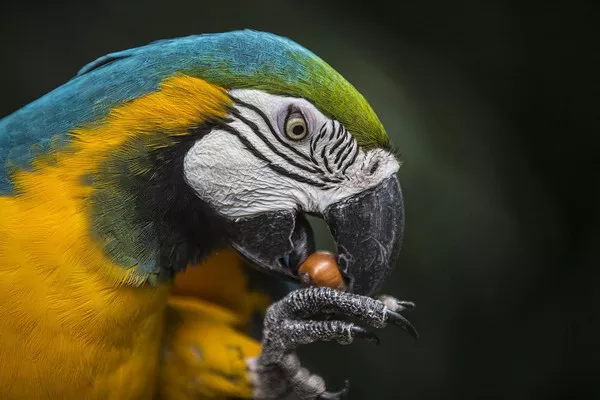What is an aye-aye?
Inhabits tropical rainforests, from virgin rainforests to dry deciduous forests on large branches or tree trunks, building spherical nests in tree cavities or branches. Live alone or in pairs, nocturnal. Eating insects. When feeding, the middle finger is often used to tap the bark to determine whether there is a cavity, and then listen closely to the ear. Because of its shrill and cry-like sound, the local people believed that the aye-aye would bring bad luck, so they would kill it once they saw it. Coupled with the destruction of the habitat, the aye-aye became extremely rare and was once thought to be extinct. Distributed in the coastal forests of eastern Madagascar.
What does the aye-aye look like?
Aye-aye has a body length of 30-38 cm, a tail length of 44-51 cm, and a weight of 2-3 kg; the head is large and flat, the face is like a fox, the snout is prominent, the snout is blunt, a pair of black ears are large and active, and the ears are very Large, membranous; body slender; limbs short, legs longer than arms. Except for the thumb and big toe, which are flat nails, the other fingers and toes have sharp claws; the black-brown body hair is composed of short soft down hairs and thick and long guard hairs, and the muzzle and the lower part of the body are gray-white. The face and belly are white, and the neck hair has a white tip; the tail is longer than the body, and the tail hair is fluffy and thick, shaped like a broom, and the hair is up to 10 cm long, black or gray.
Aye-aye living habits
Build spherical nests in tree cavities or branches on large branches or tree trunks. Different nests will be occupied by different individuals on consecutive days. They come out alone or in pairs at night, and hide in trees to sleep during the day. The aye-aye’s movement is quadrupedal, and when it descends to the ground, its limbs jump together. When foraging, it uses its unique fingers to pick the eggs in the trunk, dig out the pulp in the coconut shell, drill the egg shell to drink the egg white, and eat some bark, bamboo, etc. Because the aye-aye likes to eat insect eggs, larvae and small beetles under the bark or on dead trees, it plays the role of a woodpecker and is a “tree doctor”. There are woodpeckers on the African continent very close to Madagascar, and here they are replaced by aye-aye.
When feeding, the middle finger is often used to tap the bark to determine whether there is a cavity, and then listen closely to the ear. When eating berries, you also use your middle finger to dig a hole in the fruit and dig out the pulp from it. At night, with the sound of “Aye-aye”, the mysterious aye-aye was dispatched. These mutual calls gave it the English name “Aye-aye”. Most of the time, they are quite quiet, purring only after being disturbed; when eating, there is no gentleness at all, a fruit-eating aye-aye, chewing loudly, overflowing with juice and drooling. Hunting for bugs in tree crevices is a handy trick of the aye-aye. At first, it walks gently along the tree trunk with the tip of its nose close to the bark. When it hears or smells something, it stops and looks at it, and then it digs and bites the tree violently. skin until the hidden grub is dug out, then, reaching out with your fingers, squashes the grub and fills it in the mouth.
Aye-ayes like to eat insect larvae, small beetles and bird eggs, but do not eat large insects. Also eating sugar cane, mango, and cocoa, the aye-aye can use its powerful teeth to crack open the hard shells of fruits like coconuts. Bananas, dates and eggs were also eaten under rearing conditions.
Aye-aye feeding
Aye-ayes live on their mother’s milk until they are 7 months old, and they don’t need to worry about food sources at this time. However, after they are 2 years old, they will leave their mothers to live on their own, so how to find suitable food has become the first problem they have to face. Under normal circumstances, after weaning, the cubs will learn from their mothers the skills of predation, for example, they will learn from their mothers how to use their slender fingers to quickly obtain food and so on.
In the natural environment, the aye-aye will eat the larvae of insects, you can see that they will first look carefully like woodpeckers, and then stuff the insect larvae into their mouths by biting their mouths and digging with their fingers. In addition to insect larvae, eggs of some birds are also one of the favorite foods of the aye-aye. Because the aye-aye also lives in trees, finding the eggs is not a problem for them.
The Madagascar rainforest also provides many other foods for the aye-aye, such as various fruits. When the aye-aye sees fresh fruit, they don’t hesitate to eat it. Nuts are also contracted by aye-aye monkeys. The reason why aye-aye monkeys like to eat nuts is because they have good teeth, even if they are as hard as coconut shells, they can easily bite. Because of the variety of food, the aye-aye hardly has to worry about going hungry.
Aye-aye foraging is usually an individual behavior, but sometimes, many aye-aye foraging together. All the aye-aye monkeys in the zoo are provided with sufficient and nutritious food. Under such conditions, the aye-aye can live for more than 20 years.

















